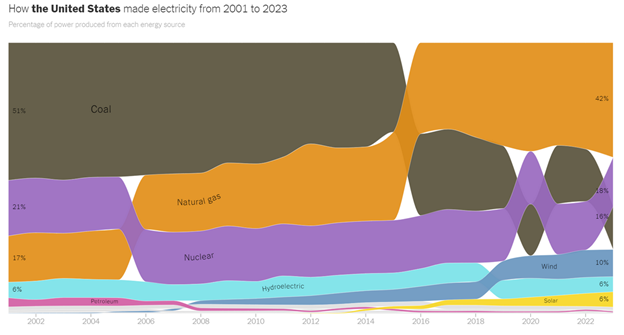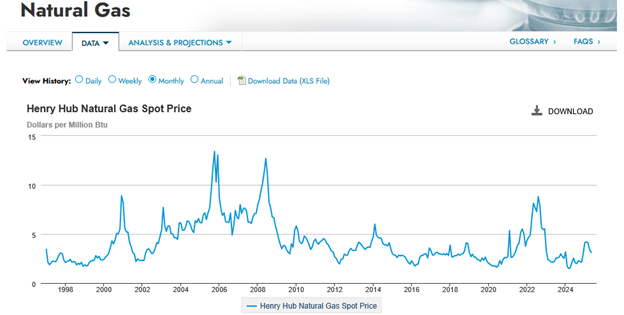“AI is big business” is a gross understatement. The IEA estimates that “the market capitalization of AI-related firms in the has grown by around USD 12 trillion since 2022.” For perspective, the chart below shows that only the U.S., China, and the European Union (EU) have total stock market caps exceeding $12 trillion. While AI’s potential is awe-inspiring, we mustn’t overlook its Achilles’ heel.
There is no AI without energy fueling the data centers that run the models.
Ironically, AI’s success hinges on a most basic technology first harnessed over 1.5 million years ago: energy.
Despite concerns regarding the electrical power grid, there are solutions to meet the surge in AI-driven energy demand. For example, nuclear energy is making a comeback. The problem is that it can take eight or more years to build nuclear facilities. Renewable energy sources are becoming increasingly efficient and are being utilized to a greater extent. However, their reliability and efficiency are problematic.
Fueling AI data centers requires a bridge to span the gap between future energy sources and the structural limits of today’s power grid.
This two-part article discusses one such bridge: and Behind the Meter solutions (BTM). Part One of this article focuses on BTM solutions, and Part Two will focus on investing in companies involved in these solutions.
Note that the demand stress on the electrical grid is coming from AI data centers, including hyperscale centers, as well as the growing needs of the cloud. This article combines those needs and loosely refers to them as AI-driven.
Natural Gas Is The Bridge Energy
Per the EIA, natural gas accounts for over 43% of utility electricity generation. The graph below, courtesy of The New York Times, illustrates that natural gas is the dominant fuel source for our power grid. It is also the fastest-growing.
Natural gas is abundant and cheap. Consider that globally, natural gas is burned off due to a lack of infrastructure or enough economic incentive to capture it. Furthermore, natural gas is a byproduct of the shale oil boom. According to the World Bank’s Global Gas Flaring Tracker, approximately 148 billion cubic meters (bcm) of gas were flared in 2023. That accounts for nearly 4% of natural gas production.
Moreover, attesting to its abundance is the price of natural gas. Despite US consumption rising by over 50% in the last 20 years, the price remains the same today as it was in the 1990s, as shown in the graph below, courtesy of the Energy Information Administration (EIA).

Thus, the question of fueling AI data centers is not about the energy source. Instead, it appears to be about the quickest and most efficient way to use natural gas to enable AI data center growth. One such answer is BTM solutions.
It’s worth noting that data center operators are shifting away from renewable energy sources, such as wind and solar, as they are not reliable enough.
What Are BTM Solutions?
Data center operators, including Microsoft (NASDAQ:), Amazon (NASDAQ:), and Google (NASDAQ:), have begun bypassing traditional power grids and sourcing natural gas directly. By diverting natural gas using a lateral pipeline from a primary natural gas pipeline, they can feed an on-site power plant and generate electricity. Think of it as a mini-utility power plant devoted to fueling the data center with electricity.
The concept of BTM solutions is not a new one. For example, a solar panel on top of a house alongside a converter and battery also bypasses the electrical grid. However, a BTM solution using natural gas and on-site power plants is a relatively new approach.
The following are a few of the benefits and costs of BTM solutions for data centers.
Grid Independence and Reliability
Data centers require a continuous and reliable power source. Grid outages and temporary energy limitations put data centers at risk. Thus, assuming sufficient natural gas is adequately flowing through a pipeline, data centers can avoid any limitations that relying on the traditional power grid may have.
Costs
Data center operators can hedge natural gas, thus locking in future natural gas costs instead of relying on volatile electricity prices. Moreover, they also avoid grid connection fees and, in some cases, receive tax incentives for not adding further pressure to already strained power grids.
Furthermore, it is envisioned that data center clusters will occur. This will allow multiple data centers to share in the costs of building out and operating BTM power plants.
Deployment Speed
Data centers can get online much quicker using BTM solutions. Because they are not reliant on the local power grid, they do not have to deal with regulatory and permitting holdups, transmission upgrades, and the time required to physically hook up to the grid. Direct pipeline hook-ups can save months to years of deployment time.
Reduced Power Losses
It is estimated that the long-distance transmission of electricity results in a loss of 5-10% of the electricity. On-site power generation has virtually zero slippage.
Financial And Political Costs
Building a gas-fired power plant for a data center is a significant investment, with costs varying based on capacity, location, and specific requirements. In 2020, the EIA provided guidance on the costs for data center power plants. The following is a Grok summary of its report:
For a data center requiring 100–200 megawatts (MW), a common range for hyperscale facilities, this translates to $70–$240 million. For example, a 200-MW plant in Ohio for a Meta data center is estimated at $1.6 billion, likely including additional infrastructure like substations. Larger projects, such as the 4.5-GW plant planned in Pennsylvania for data centers, can reach $10 billion, though this serves multiple facilities.
Costs are lower for simple-cycle plants ($713–$1,175/kW) but these are less efficient and typically used for peaking. Key cost components include the turbine (40%), construction (20%), equipment (15%), and site work/permitting (10–15%). Economies of scale apply, with larger plants having lower per-kW costs.
Additional Considerations: Beyond construction, costs include pipeline connections (e.g., $5 million for a 5-mile pipeline interconnect in Pennsylvania), backup systems like batteries or diesel generators, and cooling infrastructure critical for data centers. Operating costs are relatively low, around $50 million annually for a 1-GW plant, driven by cheap natural gas and maintenance.
However, regulatory hurdles, labor shortages, and supply chain issues for components like turbines can increase costs by 43–46%. If carbon capture is incorporated, as planned by ExxonMobil, costs rise significantly, though specific figures are unavailable. Building on-site avoids grid interconnection fees but requires land and permitting, which can be streamlined compared to grid-tied plants.
We want to emphasize the reference to regulatory hurdles. The following assessment is from a regulatory executive overseeing the utility sector. He wishes to keep his name undisclosed.
Many states remain hostile to natural gas, making it extremely difficult or impossible to build new natural gas generators. Companies will rationally pick friendly states; however, there is regulatory volatility at the federal level. Biden’s EPA had a rule that would have effectively banned new natural gas generation by requiring unproven and uneconomic carbon capture and sequestration technology. The courts overturned the rule, but a new president could easily reinstate Biden’s policy. Additionally, we require significant growth in natural gas pipeline capacity, another infrastructure challenge that often sparks controversy.
He opines:
All of this leads to a political point. If the US is going to get serious about winning the AI battle with China and others, there needs to be a sea change in thinking that embraces all manner of new energy infrastructure.
Summary
With an understanding of how BTM solutions can efficiently fuel AI data centers with an abundant and inexpensive source of energy, we will proceed to a discussion of the companies that may benefit from this approach.
In Part Two, we will focus on natural gas pipeline companies, manufacturers of natural gas power plant equipment, and ETFs that provide some exposure to BTM solutions. Additionally, we provide general guidance on BTM investment strategies and considerations.
